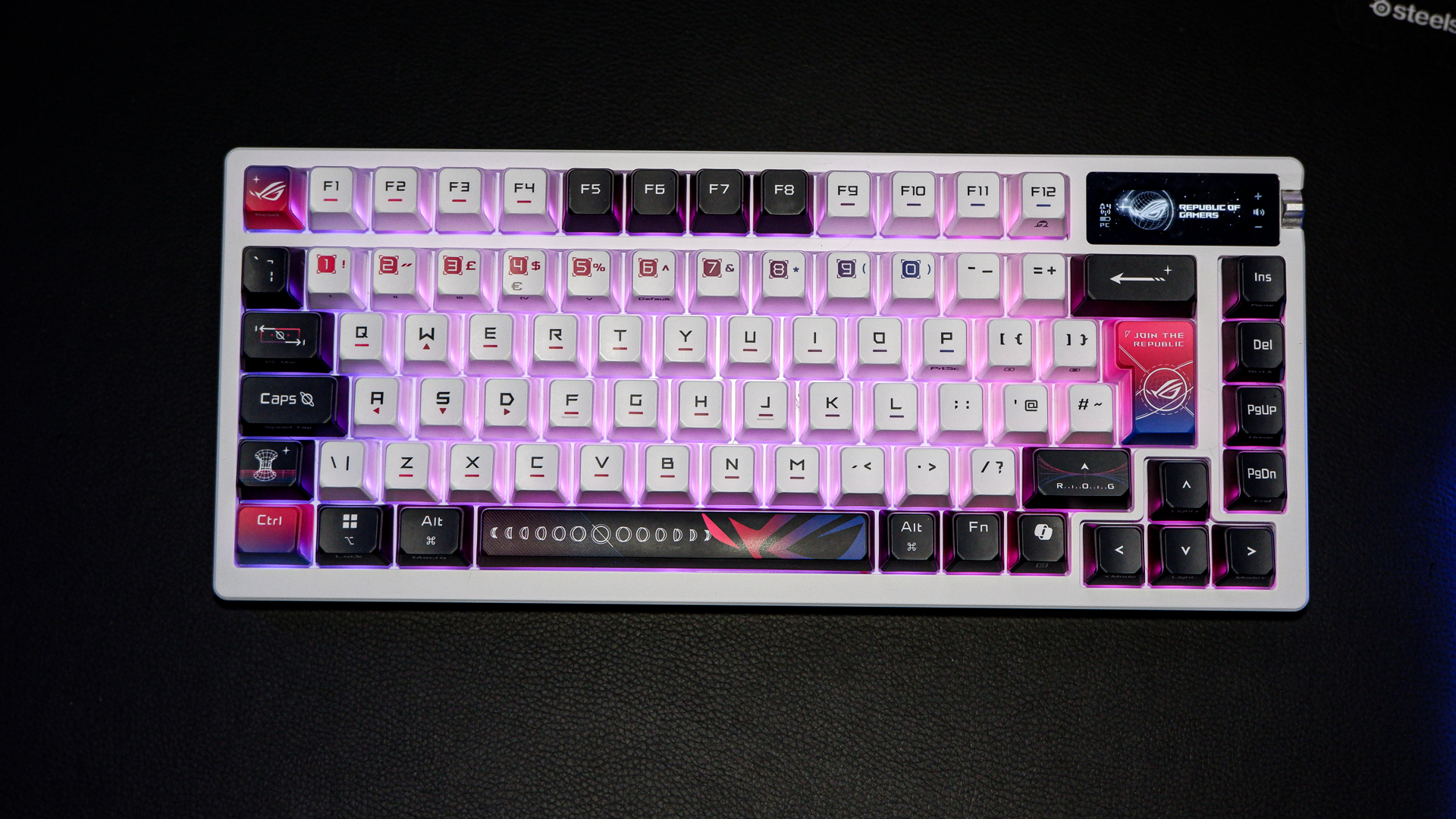Our Verdict
To complete the look, Asus could’ve, and should’ve, done more to shake up the ROG Azoth X compared to its predecessor, the ROG Azoth. As it stands, it’s practically a new colourway and little more for the Azoth, with no real reasons to spend the extra cash it demands.
For
- Good silicone wrist rest
- It’s different
- Smooth linear switches
Against
- Considerably more expensive than the original, and very similar, Azoth
- Lighting isn’t as bright as I’d like
- No shine-through legends
- Screen is a bit pointless
PC Gamer’s got your back Our experienced team dedicates many hours to every review, to really get to the heart of what matters most to you. Find out more about how we evaluate games and hardware.
Asus has been on a tear with its gaming keyboards lately. I’ve tried most of its recent gaming keyboards, from the ROG Strix Scope II 96 Wireless to the compact Falchion RX, and I’ve liked pretty much every single one. You’d expect me then to shower the ROG Azoth X with the same praise, but I’m not quite as convinced by this one.
The Azoth X is a refresh of the existing ROG Azoth. They share a great deal: a 75% layout, more or less identical chassis design (including space to store the 2.4 GHz dongle), and a 2-inch OLED screen in the top right corner. On the surface, they appear incredibly similar, especially if you’re comparing the Azoth X with the original Azoth in white.
The Azoth X does switch things up a little. For starters, the switches have been upgraded to the company’s newest ROG NX V2 switches, either Snow V2 or Storm V2. I’ve got the Snow V2 version here, which is a linear switch and most suited to gaming.
I have to hand both the ROG Strix Scope II 96 Wireless and ROG Azoth Extreme with Snow switches, which makes for a theoretically straightforward comparison between the V2 and V1 versions of the switch. Yet in all my years of pressing key switches—eight or so professionally—I can’t massively tell them apart. The V2 may have a little more spring to it, a smidge, but I’ve been tapping a couple keys on each keyboard for about 10 minutes straight now and I’m not sure if any differences I’m now noticing are my mind playing tricks on me. All three feel incredibly smooth, on account of the lube applied at the factory, and all are consistent switch-to-switch, though there is a distinct difference in their overall tone.
Azoth X specs
The Azoth Extreme has the best typing feel, which is punctuated by the light and airy pitter-patter of each key press as you type. The Strix Scope II 96 Wireless mimics this to some extent, though feels a little spongier by comparison. The Azoth X is the clunkiest and least inviting on noise and overall typing feel, which I feel comes down to the keycaps. Keycaps that are, according to the Azoth box, made from PBT, though they feel tacky and lack the slightly granular feel of other PBT caps, including those on previous Asus boards. Though I should state that none of these three offers a poor typing experience, just different grades of good.
The keycaps are supposedly the big sell for the Azoth X. The keys are a bit out there, with spacebar, enter, tab, shift, and caps lock keys brandishing planetary motifs and phrases such as “Join the republic”. The letter keys even have thin lines with a pink/purple gradient across them, which matches the gradient on the number row. The surrounding keys and part of the function row come in a darker colourway, which I’m not opposed to—two-tone keyboards can look pretty great, and this one does have something about it to draw the eye.
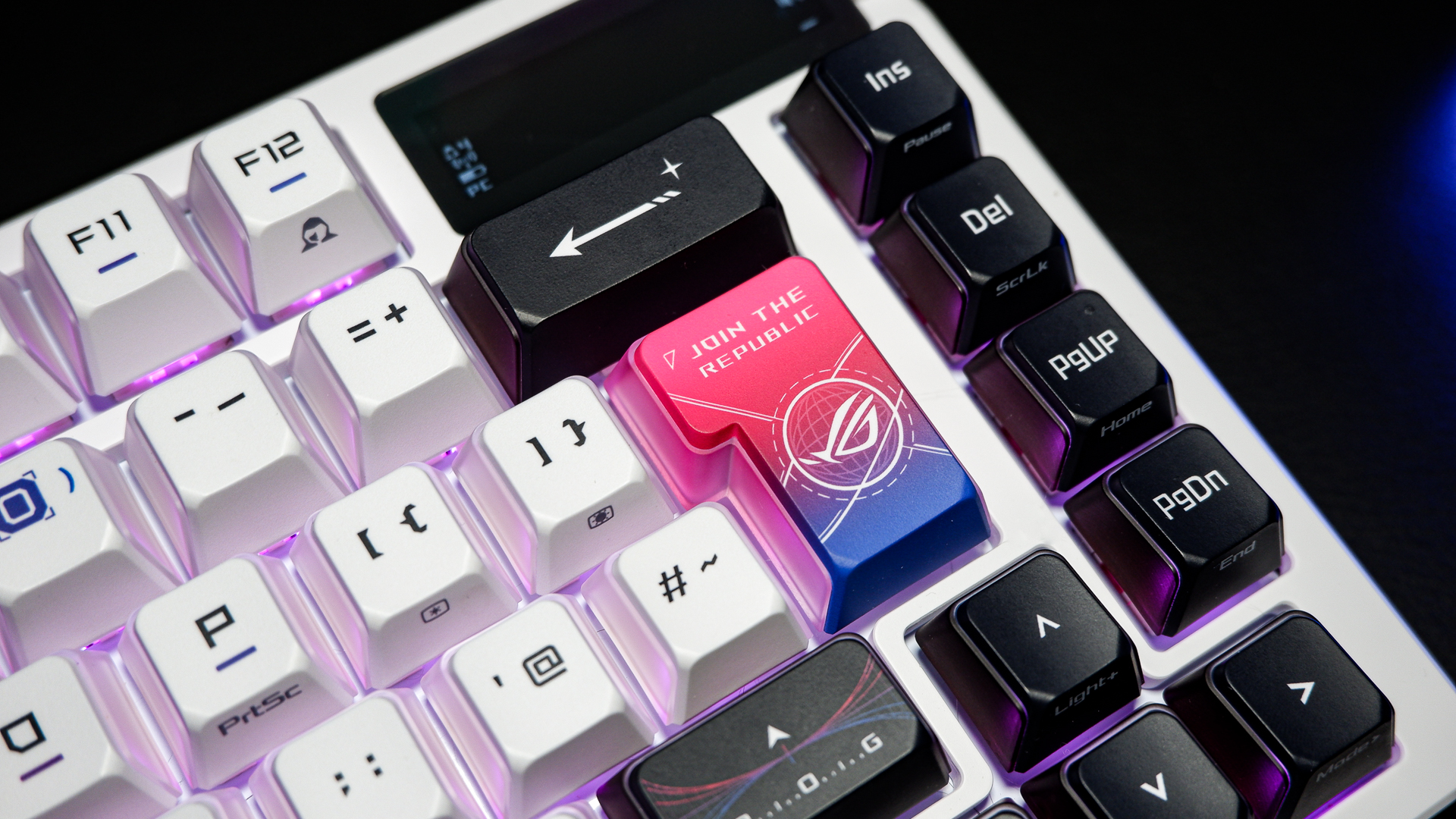
The look of this keyboard is sure to be a case of, if you like it, you like it. If you don’t, it’s a bit much. Either way, it does mean you’re stuck with this theming for your desktop, rather than your own machinations, which slightly in my mind defeats the point of the addressable RGB lighting underneath each key. Hey, it does look good lit up in a purple or pink gradient to match, shining through the oddly designed semi-translucent keycaps.
These keycaps are translucent on three of four sides. The remaining side and the top of the key contain the legends, though these are not shine-through. What’s even weirder is the RGB LEDs on each key switch face the opaque side of the switch, sitting closest to the bottom of each key (a so-called south-facing PCB design), and thus reducing the visible glow through the translucent sides of the keys. It does mean the actual diode is hidden behind the opaque side of the switch, preventing any undue ugliness, but I feel a north-facing LED would’ve largely achieved this same effect.
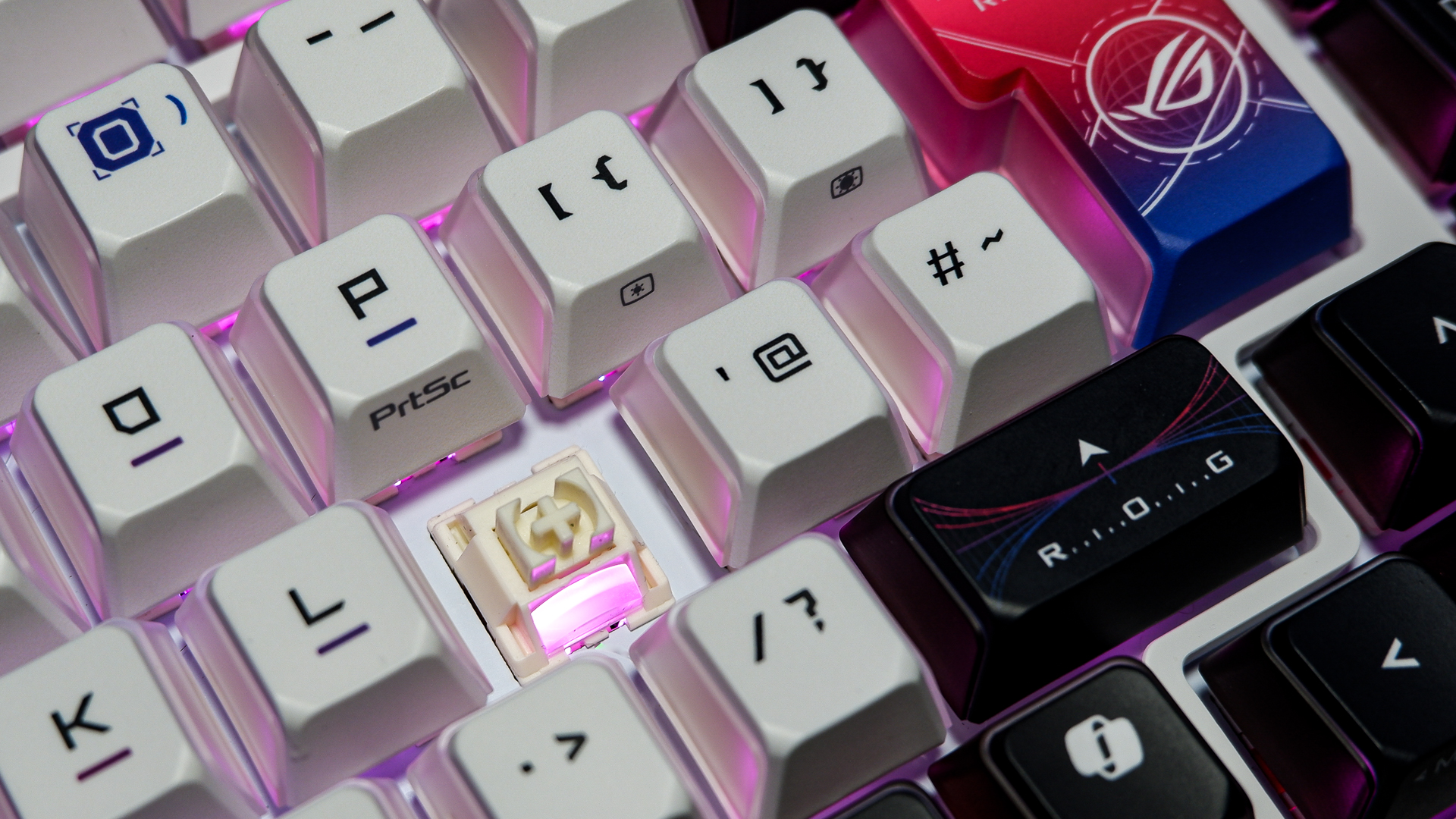
In Asus’ defence, it may have decided to use a south-facing PCB design due to this approach preventing potential compatibility issues with north-facing LEDs, wherein certain key profiles bottom out on the LED housing rather than the switch’s true stopping point. Though I’ve never knowingly had that issue—or at least I’ve never noticed it.
It’s tricky to judge. It doesn’t look bad, per se, but I feel it could look a lot better. Especially as I think this keyboard’s promise is its out-of-this-world aesthetic, which is slightly more muted in reality. Some sort of ambient lighting or underside glow might’ve added to the look, but the Azoth X seems such a carbon copy of the original Azoth that Asus hasn’t changed anywhere near enough to get the complete look.
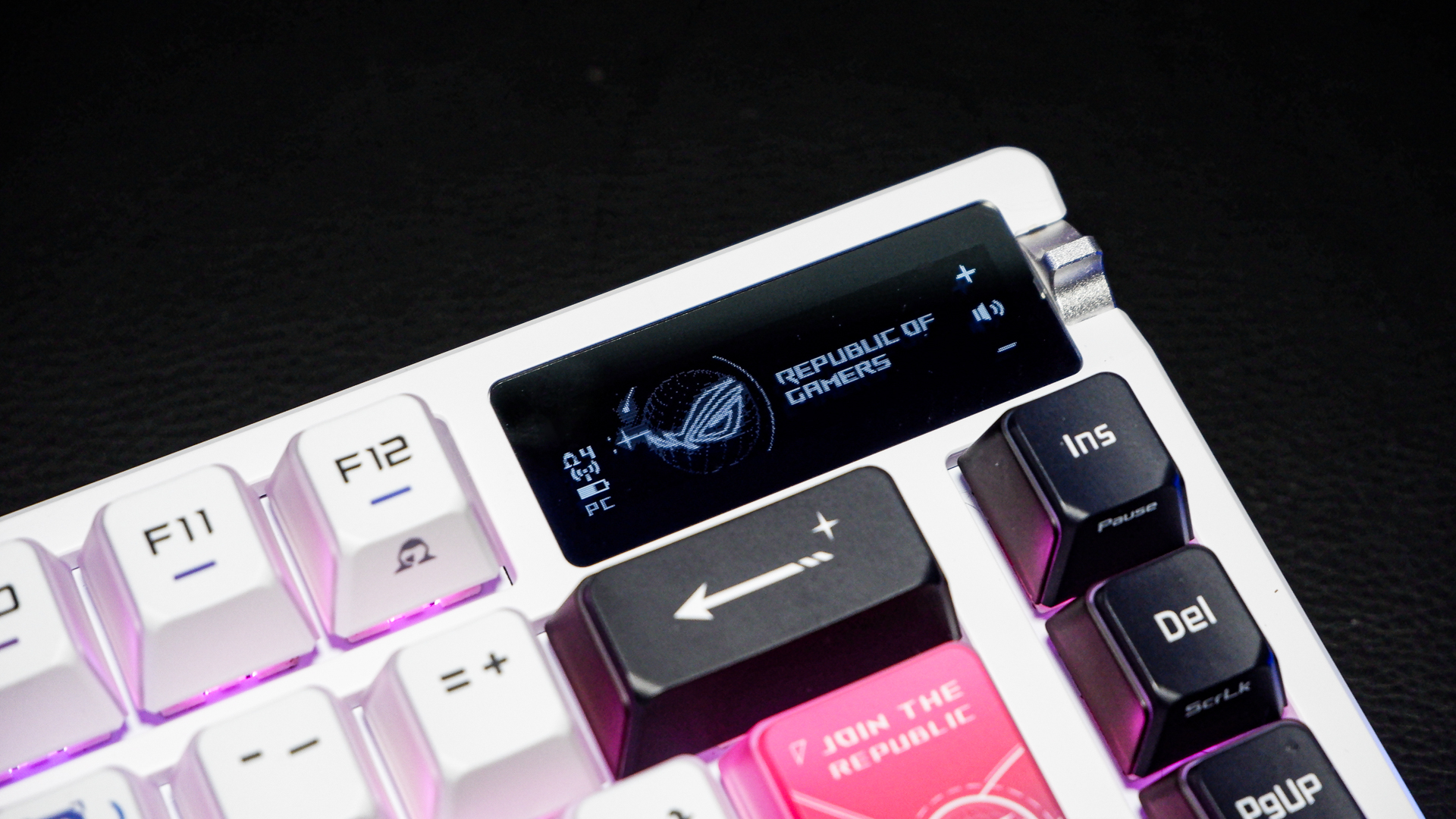
As for the screen, I’ve been spoiled by the Azoth Extreme’s full colour unit. The black and white panel on the Azoth X is the same as the one on the Azoth, and it’s nowhere near as glossy or good-looking. Even the best keyboard screens I’ve used, however, I’ve thought to be pretty frivolous. A screen can be moderately useful on a competitive gaming keyboard with lots of on-the-fly options and customisable keys, such as with SteelSeries’ Apex 9 TKL, though more often than not a screen adds to the cost and offers little in return.
As for the Azoth X’s screen, it can be used to control the lighting, brightness, and multimedia control. It’s often easier to adjust these in the Armoury Crate app, however, and I find myself wishing for straightforward multimedia controls so that I could use the buttons more reactively for volume control without accidentally messing with anything else.
Buy if…
✅ You love sci-fi stuff: There is something to like about the aesthetic of this board. It definitely piqued my interest when I first saw it. It looks good in person, too, but I am underwhelmed with the lighting.
Don’t buy if…
❌ You just want a top typing experience and a compact board: The original ROG Azoth is cheaper, though the slightly larger Strix Scope II 96 Wireless is even cheaper still. Even better, I’d argue, for pure typing experience, is the Keychron Q3 Max.
Sure, if the Azoth X was the same price as the original Azoth, you might just think it’s merely a fun, quirky colourway for the pretty popular compact keyboard. But it’s nowhere near the same price. The original Azoth costs $209/£210 right now. The Azoth X costs $300/£275. While the older board is benefitting from discount prices since its launch back in 2023, the Azoth X is actually more expensive than the Azoth was at launch.
There is a small bonus for buying the Azoth X. There’s a soft-touch silicone wrist rest included in the box, taking the place of the tub of lube and brushes included on the original Azoth, in case you want to kill an evening lubing up your switches a little more. I’ve been there, it’s a bit of a novelty to lube your own switches once, but I appreciate the wrist rest more. Especially as the NX switches are already pre-lubed. Though it’s hardly enough to justify the leap in price.
That’s ultimately the biggest issue with the Azoth X. It’s geared up to be something new and exciting, but it’s more of a colourway for the existing Azoth than anything truly fresh. That makes its price premium incredibly tough to swallow. What’s more, I prefer the practicality, simplicity, and ease of the Strix Scope II 96 Wireless, which is $161/£126. We’re not even looking beyond Asus yet and we’re already finding much better options, but I’d recommend the Keychron Q3 Max for an alternative if you’re seeking superb typing feel and a two-tone style. I use this keyboard in the office and I’ve had many compliments on it, including convincing one colleague to go and buy one themselves. And while I don’t think everyone needs a Hall effect keyboard, they are great for many competitive gamers, and you can nab the best Hall effect keyboard for less than the mechanical Azoth X, too.
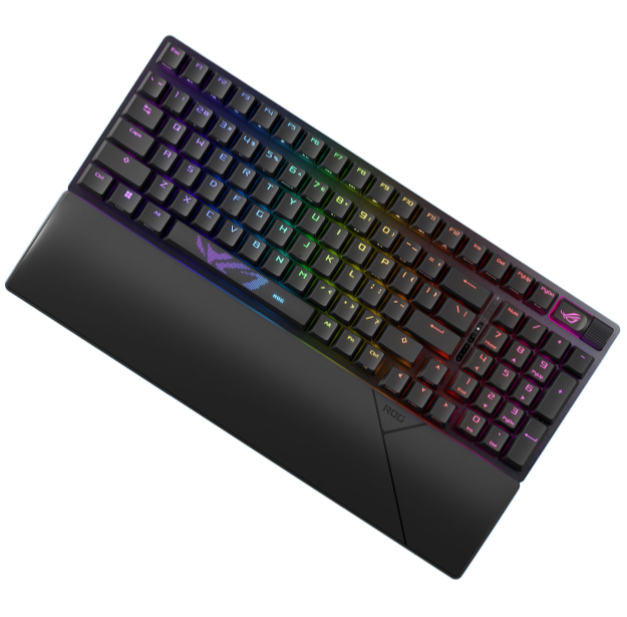
Best gaming keyboard 2025
Asus ROG Azoth X
To complete the look, Asus could’ve, and should’ve, done more to shake up the ROG Azoth X compared to its predecessor, the ROG Azoth. As it stands, it’s practically a new colourway and little more for the Azoth, with no real reasons to spend the extra cash it demands.
“>
You must confirm your public display name before commenting
Please logout and then login again, you will then be prompted to enter your display name.

